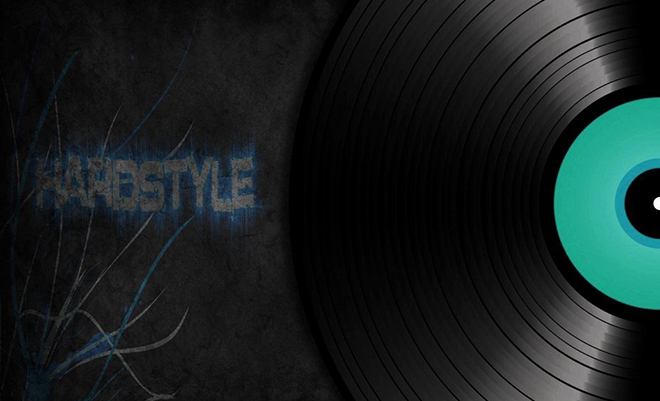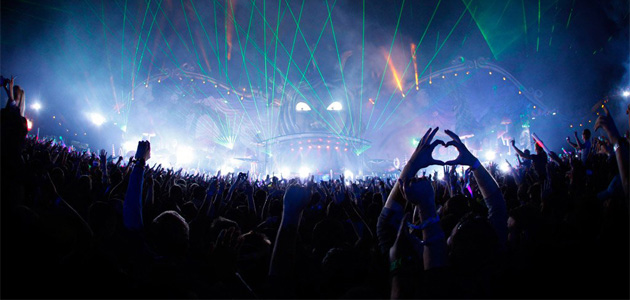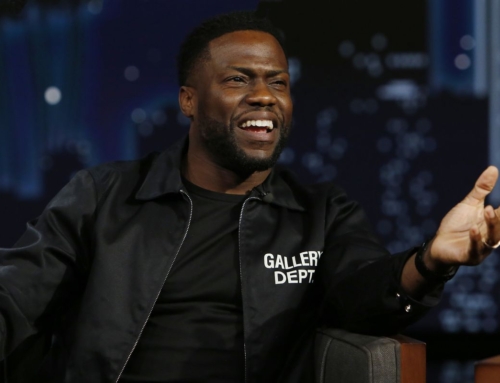As EDM becomes more of a fixture in the American musical landscape, one subgenre ascends to novelty status each year. Often, the sounds lasted close to a decade in some other context. Dubstep became 2012’s “it” attraction, while a year later, fickle fans turned toward trap – a style originating in hip-hop but quickly adopted by and incorporated into EDM tracks.
2014 looks to be the year of hardstyle – a subgenre that reached commercial status in Europe in the early 2000s and quickly grew from there. Since 2012, festivals saw the 150-plus BPM and kick drums become a moderate fixture, and American listeners haven’t rejected it quite yet.
To the untrained ear, hardstyle appears to fall within the “cheesy” range of electronic music subgenres. Synths and beats borrow heavily from Eurodance, sounding as if someone took a Cascada track, removed the vocals, and sped it up. Stages at major European festivals, like Q-Dance and Defqon 1, look like something more appropriate for an Insane Clown Posse show on this side of the Atlantic, while fans, as extensive YouTube evidence shows, tend to get their shuffle on in wide leg JNCO-style pants.
Yet despite all the criticism and eye-rolling thrown at hardstyle, it has developed like any other dance subgenre. Sounds originate from trance, gabber, and hard trance, while its culture rose from European clubs – like other subgenres, the Netherlands appear to be where it’s concentrated, but there’s also a separate U.K. sound – and then evolved toward festivals reminiscent of North American EDM events.
But being prominent in Europe doesn’t seem to be where its major producers and promoters – particularly Headhunterz and Q-Dance, respectively – want it to stay. Between working with Insomniac and collaborations with David Guetta, hardstyle’s already started its path into the North American market.

1. Major DJs are now including hardstyle beats in tracks
Hardstyle’s now going through the exoticism treatment that both dubstep and trap went through. Two years ago, dubstep became the perfect producer’s playing, with everyone from Sander Van Doorn to Diplo adding it into a set. Then, you could say dubstep wore out its welcome officially by 2013 – when, by that point, mainstream radio heard it through Justin Bieber’s “As Long As You Love Me” and Taylor Swift’s “I Knew You Were Trouble.”
Trap experienced an equally-similar pattern. 2013 saw Baauer’s “Harlem Shake” take off – and save Diplo’s Mad Decent label in the process – and ended with Miley Cyrus’ “We Can’t Stop” by the fall.
So for hardstyle, Diplo’s at the helm again, adding the kick drum beats to tracks on Major Lazer’s Apocalypse Soon.
A close second in terms of mainstream adoption is David Guetta, who, looking to make himself a legit dance music presence again, collaborated with Showtek. While the duo, who’ve put out releases through Spinnin’ Records, appears to be the most mainstream act for the subgenre, they’re not as well-known outside of the dance music world.
With its growing presence comes parody tracks, which Deadmau5 did in response to Wildstylez allegedly stealing the structure from “Some Chords.” “Dat Kick Doe” isn’t a true hardstyle track, but Deadmau5’s effort clearly shows the subgenre’s clichéd points – as well as, inadvertently, that creating hardstyle isn’t as easy as it seems.
2. Crossover artists
Within the strata of dance music – underground, well-known in the genre, and officially mainstream – Showtek sits on the edge of getting toward the top. They’ve had a few successful singles that blend hardstyle with house and, as mentioned above, already collaborated with David Guetta – a move that helped launch mainstream careers for Avicii, Afrojack, and Nicky Romero.
But within the middle level sits Headhunterz – an artist that has been pushed on North American listeners. His Huffington Post article about bringing the subgenre across the ocean – kind of a meta move, considering his touring schedule – spoke about getting out of stagnancy while still giving listeners what they want.
If you didn’t listen to Headhunterz’s actual music, his career mirrors the paths of many progressive house producers now topping the charts: He operates his own label, has been a major draw at both major American and European festivals, and has his own podcast.
And, as Headhunterz has the greatest crossover potential, he’s had his own solo North American tour.
Part of being a “crossover artist” involves taking on pop trends, and some hardstyle producers are already starting to do this. Speaking with the Daily Trojan before a hardstyle event in California, producer Fabian Bohn observed that more subgenre artists have started adding vocals and aiming for an uplifting feel – one that could blend with house eventually. “These days it’s really important to make a good overall song,” he said, “and five to six years ago it was more about the kinds of sounds and the build-up and the drop, so in my opinion, it’s gonna evolve even more, and I think hardstyle will grow up to a sound that’s between house and what it is right now.”

3. Major festival stages
If small club tours and major festival stages seem diminutive, hardstyle’s ticket into North America is the culture.
Once you get past the superficiality of neon colors, skulls, and guns, fans’ fervor and turnout at major European events, such as Qlubtempo, Qlimax, Hardbass, and Defqon 1, lends itself easily to the atmosphere of Ultra Music Festival and Electric Daisy Carnival.
American promoters notice the similarities, and as a start, Insomniac partnered with Q-Dance in 2012. This led to an exclusively stage at Electric Daisy Carnival, creating what’s considered the first official hardstyle event in the United States.
TomorrowLand’s promoters followed, erecting a similar setup at the first TomorrowWorld in the U.S. last year.
Now, the next strategy appears to be making separate hardstyle events, with The Sound of Q-Dance held last year and again in March 2014 in Los Angeles.
However, the promoters, rather than fully bowing to the American mainstream, still want to keep the subgenre’s underground culture intact. “In the States it’s pretty new and kind of small, but it’s out there. It has to grow, but you can’t force it,” Q-Dance’s Roger Werver told Billboard’s Kerri Mason. “We cannot go any faster than we’re going because we need the scene.”
He followed that with: “We came from the underground and there’s still a link to it. We now do events for thousands and thousands of people, but that connection is something we cherish and don’t want to lose.”





